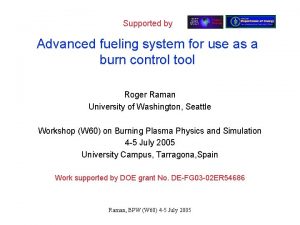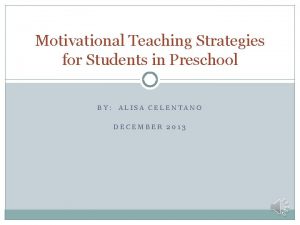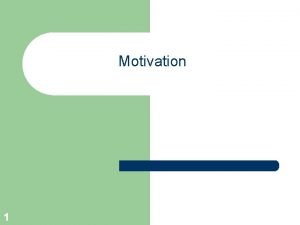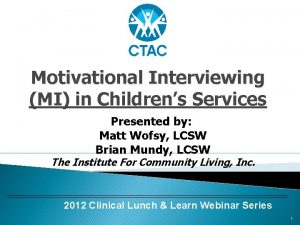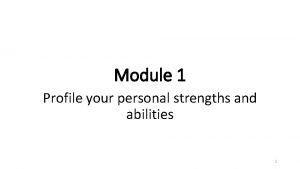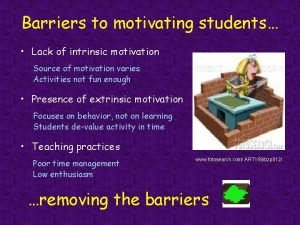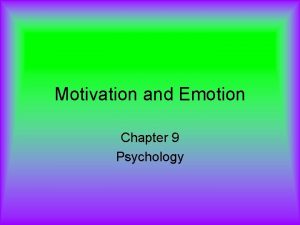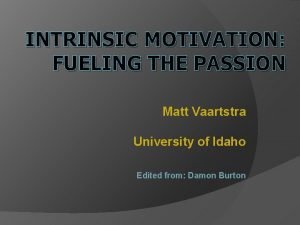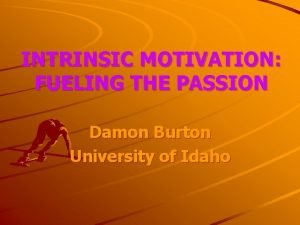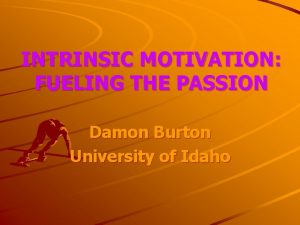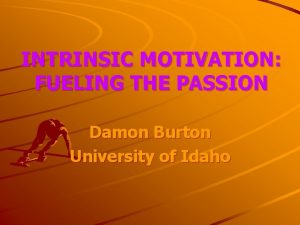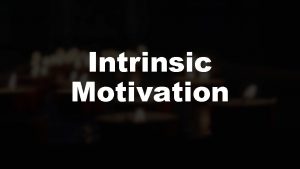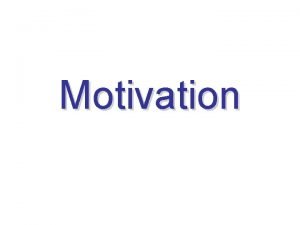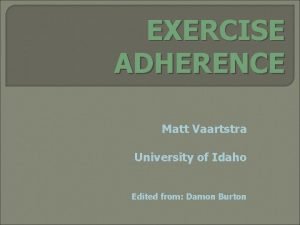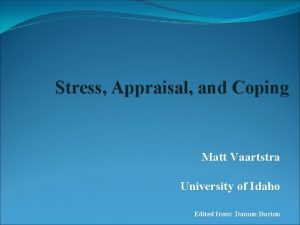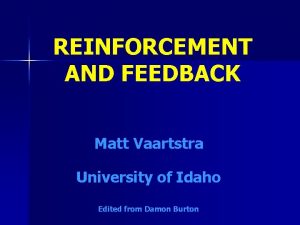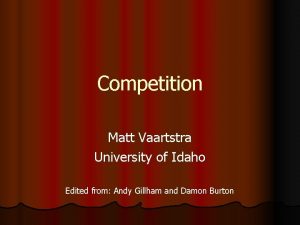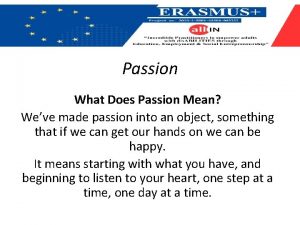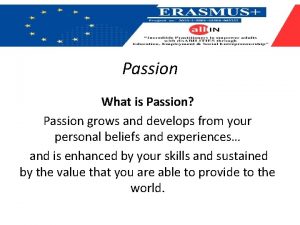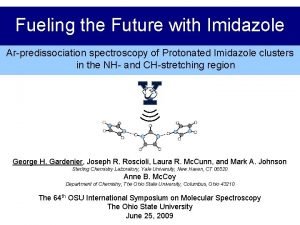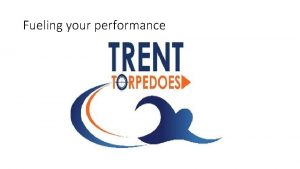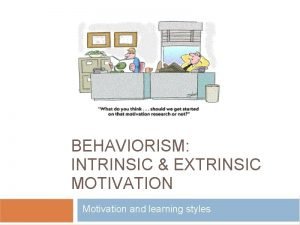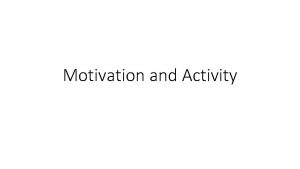INTRINSIC MOTIVATION FUELING THE PASSION Matt Vaartstra University























- Slides: 23

INTRINSIC MOTIVATION: FUELING THE PASSION Matt Vaartstra University of Idaho Edited from: Damon Burton

Motivation Defined � Two primary components of motivation: �Intensity of effort �Direction of effort � Motivation is how much effort you give combined with where you decide to put that effort. � Where does motivation come from?

Intrinsic Motivation Defined � Intrinsic Motivation (IM) – engaging in an activity for its own sake, particularly the pleasure and satisfaction derived from playing � For example, a girl who skis because of the fun she has doing what she wants, challenging herself by trying new things and being with her friends skiing fresh powder on the mountain.

Components of Intrinsic Motivation � Competence – feeling talented and skilled � Autonomy – in control, self-determining, & doing what you want � Relatedness – feeling connected and enjoying relationships with others

Extrinsic Motivation Defined � Extrinsic motivation – engaging in behaviors in order to attain contingent outcomes beyond of the activity itself (i. e. , rewards, fame, prestige, etc. ) � For example, a boy plays basketball to be recognized, get their name in the paper, and win a college scholarship.

Self-Determination Theory (SDT) � SDT describes the social factors that will promote intrinsic motivation and internalized forms of extrinsic motivation. � Autonomy is necessary to attain true competence and relatedness. � SDT determines how extrinsic rewards will influence intrinsic motivation.

Self-Determination Continuum Low 1 2 3 Amotivation 4 5 6 Extrinsic Motivation 1. Amotivation 2. External Regulation 3. Introjected Regulation 4. Identified Regulation 5. Intrinsic Motivation to Experience Stimulation 6. Intrinsic Motivation to Accomplish 7. Intrinsic Motivation to Know 7 High Intrinsic Motivation

Amotivation �Amotivation – refers to lack of intentionality or absence of motivation. �High amotivation prompts feelings of incompetence and low expectancies due to the belief that success is uncontrollable.

Extrinsic Motivation – External Regulation • External regulation (EM-ER) - refers to behavior that is regulated through external means such as rewards and constraints. • For example, an athlete might go to practice because she wants to play in the game tomorrow.

Extrinsic Motivation Introjected Regulation • • • Introjected Regulation (EM-IR) -- individuals begin to internalize the reasons for their actions. Behavior not self-determined because they experience self-imposed pressure through guilt and anxiety. For example, athletes go to practice because they feel guilty if they miss a session.

Extrinsic Motivation Identified Regulation • EM-IR emitted out of choice. • Under EM-IR, athletes highly value the activity, judge it to be important and choose to engage in it. • For example, a soccer player doesn’t enjoy weight training but lifts to become a better player.

Intrinsic Motivation to Experience Stimulation • IM-ES describes when one performs the activity to experience pleasant sensations (i. e. , sensory and aesthetic pleasure). • For example, a swimmer swims because she enjoys the pleasant sensations of her body gliding through the water.

Intrinsic Motivation to Accomplish • IM-A involves engaging in an activity for the pleasure and satisfaction gained from attempting to accomplish or create something or to surpass your previous performance. • For example, a tennis player who works on his serve for the pleasure they experience while trying to hit an ace.

Intrinsic Motivation to Know • IM-K refers to engaging in a activity for the pleasure and satisfaction experienced while learning, exploring, or trying to understand something new. • For example, a basketball player practices a new press offense because they enjoy learning new ways to attack the opponents’ press.

Factors That Influence Motivation � Personal Factors: �Personality �Needs �Interests �Goals � Situational Factors: �Coach style �Facility �Team record �Competitive level

Motivation as a Social Phenomenon � The impact of social factors on motivation is mediated by perceptions of competence, autonomy, and relatedness. � Motivation is not influenced by social factors directly. � The way individuals interpret social factors depends how they facilitate their needs for competence, autonomy, and relatedness. � Individuals are motivated to engage in activities to meet these needs.

Social Factors Reducing Intrinsic Motivation � Social factors influencing intrinsic motivation include: competition, evaluation/feedback, and rewards. � Competition tends to decrease IM. � Winning and playing well enhances IM, whereas losing and playing poorly lowers IM. � Positive feedback increases IM, while negative feedback reduces IM. � Rewards can both raise and lower IM in different situations.

How do Rewards Impact Intrinsic Motivation � Reward impact not determined by number or size of rewards. � Impact determined by “message” behind the reward. � How well does the reward enhance perceptions of competence, autonomy, and relatedness?

Relationship Between Intrinsic and Extrinsic Motivation � EM + IM = TOTAL MOTIVATION (TM) 1 IM = TM 2 IM = TM If EM lowers perceived competence, autonomy, and/or relatedness, IM and TM decline. 2. If EM increases perceived competence, autonomy, and/or relatedness, IM and TM improve. 1.

Rewards Promoting Intrinsic Motivation � Contingent Rewards – received for attaining a standard of excellence (e. g. , trophy for winning a tourney) � Non-contingent Rewards – no standard of excellence (e. g. , winning lottery) � Contingent rewards normally increase IM, because they increase feelings of competence and autonomy. � Non-contingent rewards reduce IM.

Perceptions Key to How the Message is Interpreted � How athletes perceive the reason rewards are given is the key to IM. � Autonomy is necessary to develop strong competence and relatedness. � If rewards are view as controlling, it lowers feelings of competence and relatedness too, reducing IM. � If rewards are viewed as informational about competence, autonomy and IM must be high as well.

Factors Promoting Intrinsic Motivation �“Autonomy support” from coaches, parents, and peers � The competitive structure of the league (i. e. , varsity versus intramural sports) �Motivational climate – mastery versus outcome

The End
 What is modifiers of human act
What is modifiers of human act Opw retail fueling
Opw retail fueling Advanced fueling systems
Advanced fueling systems Opw smithfield nc
Opw smithfield nc 152h-f5fbd-36
152h-f5fbd-36 Behaviorally anchored rating scale
Behaviorally anchored rating scale Prochaska and diclemente’s stages of change model
Prochaska and diclemente’s stages of change model Intrinsic motivation examples
Intrinsic motivation examples Lack of intrinsic motivation
Lack of intrinsic motivation Intrinsic and extrinsic motivation
Intrinsic and extrinsic motivation Intrinsic motivation
Intrinsic motivation Hình ảnh bộ gõ cơ thể búng tay
Hình ảnh bộ gõ cơ thể búng tay Bổ thể
Bổ thể Tỉ lệ cơ thể trẻ em
Tỉ lệ cơ thể trẻ em Gấu đi như thế nào
Gấu đi như thế nào Tư thế worm breton là gì
Tư thế worm breton là gì Chúa yêu trần thế
Chúa yêu trần thế Các môn thể thao bắt đầu bằng tiếng nhảy
Các môn thể thao bắt đầu bằng tiếng nhảy Thế nào là hệ số cao nhất
Thế nào là hệ số cao nhất Các châu lục và đại dương trên thế giới
Các châu lục và đại dương trên thế giới Công của trọng lực
Công của trọng lực Trời xanh đây là của chúng ta thể thơ
Trời xanh đây là của chúng ta thể thơ Mật thư tọa độ 5x5
Mật thư tọa độ 5x5


